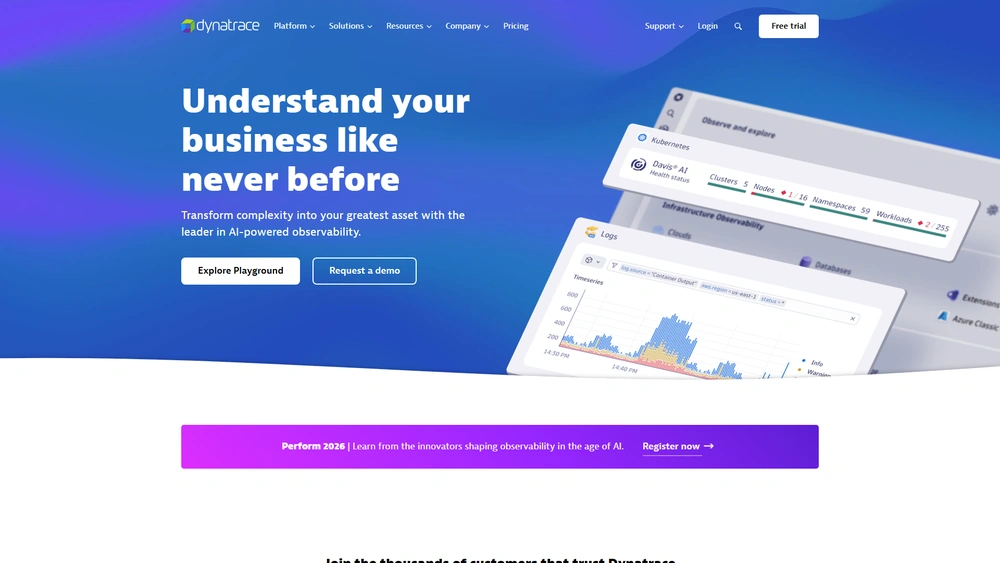Dynatrace Overview & 2025 Industry Position
Dynatrace is a leader in the software intelligence space, providing advanced application performance monitoring (APM), infrastructure observability, and AI-driven analytics for complex, hybrid-cloud environments. In 2025, its differentiation lies in its AI engine, Davis®, and the autonomous cloud enablement approach. Positioned at the convergence of DevSecOps, AIOps, and digital experience monitoring (DEM), Dynatrace is now the go-to platform for enterprises seeking integrated observability with Business Analytics and security insights tightly coupled to their cloud workflows.
From Launch to 2025: Dynatrace’s Journey
Founded in 2005 in Linz, Austria, Dynatrace initially focused on automatic performance diagnostics. After becoming part of Compuware in 2011, it split off as a standalone company, eventually going public in 2019. Over the years, Dynatrace evolved from basic APM into a full-stack observability platform, introducing its game-changing Davis AI and Grail™ for log and data management. Notable milestones include:
- 2014: Introduced Dynatrace Ruxit (later unified into its core offering)
- 2019: IPO on NYSE under DT ticker
- 2020: Launched Software Intelligence Platform and Davis AI
- 2022: Released Grail™ for large-scale unification of logs and events
- 2023: Acquired Rookout (live debugging) and Runecast (cloud security posture)
2025 Strategy Thesis: Dynatrace aims to unify observability, security, and business insights under a single AI-powered platform, reducing operational silos while boosting automation and intelligent decision-making.

Dynatrace Key Features
Dynatrace offers a comprehensive suite of services and features, built for scale and designed with AI-powered automation in mind:
- Davis AI®: Predictive, contextual, and explainable AI engine for root-cause analysis
- Grail™: Immutable, schema-on-read data lakehouse for logs, metrics, events
- Application Performance Monitoring: Complete code-to-user visibility
- User Experience Monitoring (DEM): Real-time UX insights and synthetic monitoring
- Infrastructure Observability: Full-stack visibility into hybrid environments (on-prem + cloud)
- Security (AppSec): Runtime vulnerability analysis and threat detection
- Business Analytics: Connects tech performance to business KPIs without SQL
Key verticals include finance, e-commerce, telecom, and government sectors.
Workflow & UX
Dynatrace’s modern UI/UX is clean and intuitive, focusing on intelligent automation of complex workflows. The home dashboard dynamically surfaces anomalies and business impacts in real-time. From rich data visualization to no-code workflows and automatic topology mapping, the design keeps user context central. Navigating between host views, metrics, traces, and logs is seamless, aided by Davis AI’s natural language processing and proactive guidance.
Pro Tip: Use Dynatrace Workflows to automate responses to incidents, streamline routine ops, and reduce MTTR by over 60%.
Dynatrace Pricing Analysis & Value Metrics
Dynatrace pricing is modular, pay-for-what-you-use, and designed around data ingest and monitoring capacity. Below is a simplified July 2025 pricing snapshot for key SKUs:
| SKU | Base Price (Monthly) | Includes |
|---|---|---|
| Full-stack Monitoring | $21/8GiB host | Infra + app + services monitoring |
| Application Monitoring | $69 per 100k DPUs | Services, APIs, traces |
| Digital Experience | $10 per 1,000 UEM sessions | End-user monitoring & RUM |
| Grail (Data Lakehouse) | $0.0036/field/hr | Logs, events, schema-on-read |
| AppSec | $20 per 1M requests | Runtime vulnerability detection |
Value Assessment: High TCO for small orgs, but exceptional ROI for enterprises looking to unify performance, security, and business intelligence in one platform.
Competitive Landscape
Dynatrace operates in a crowded APM and observability market, with several high-profile competitors. Here’s a snapshot:
| Platform | Strengths | Weaknesses |
|---|---|---|
| Datadog | Broad ecosystem, plugin-rich | Manual setup, dashboard sprawl |
| New Relic | Developer friendly, usage-based pricing | Limited enterprise depth |
| Splunk Observability | Great log correlation | High cost, steep learning curve |
| AppDynamics | Strong business-focus tracing | Legacy UI, slower innovation |
Dynatrace stands out for combining AIOps, observability, and security natively without relying on third-party plug-ins.
Common Use Cases
Organizations worldwide embrace Dynatrace in scenarios such as:
- Monitoring microservices and Kubernetes clusters across multiple clouds
- Real-time detection of digital experience degradation in banking and retail apps
- Security monitoring of cloud workloads and shift-left AppSec practices
- IT cost optimization and reduction of alert fatigue in large ops teams
Dynatrace Integrations
Dynatrace seamlessly integrates with major platforms and cloud-native tooling:
- Clouds: AWS, Azure, GCP
- CI/CD: Jenkins, GitLab, Azure DevOps
- Infrastructure & K8s: Terraform, Helm, OpenShift
- APM Exts: Prometheus, OpenTelemetry
- Business Stack: ServiceNow, Jira, Salesforce, SAP
The platform also features proprietary Smartscape® topology mapping for real-time integrations.
Pros & Cons
- Pros:
- Auto-discovery with no manual config
- Unmatched AI analytics with Davis
- Secure by default (runtime insights + AppSec)
- High scalability for enterprise use
- Cons:
- Higher cost for small projects
- Steep feature learning curve
- Limited customization without APIs
Final Thoughts
Dynatrace remains an elite choice in 2025 for complex digital organizations seeking high automation in observability and security. The upfront cost and learning curve are offset by time savings, cross-team intelligence, and performance-to-business visibility unmatched by competitors. Ideal buyers include DevOps teams, SREs, security teams, and cloud architects in mid-to-large enterprises. Not ideal for small SaaS startups or hobby projects.
Dynatrace FAQ
No, Dynatrace offers both SaaS and Managed (on-prem) deployment options depending on data residency or compliance needs.
Dynatrace is more automated and AI-centric, with broader enterprise capabilities. Datadog is wider in integrations but often requires manual config.
Davis AI is Dynatrace’s core engine, correlating billions of metrics and logs in real-time to provide root cause and anomaly detection automatically.
Yes, fully. Dynatrace integrates native OpenTelemetry traces, metrics, and logs while adding AI-driven correlations on top.
Absolutely. It includes BizOps capabilities, allowing non-technical users to tie performance to business outcomes like revenue drops, conversions, and SLAs.
